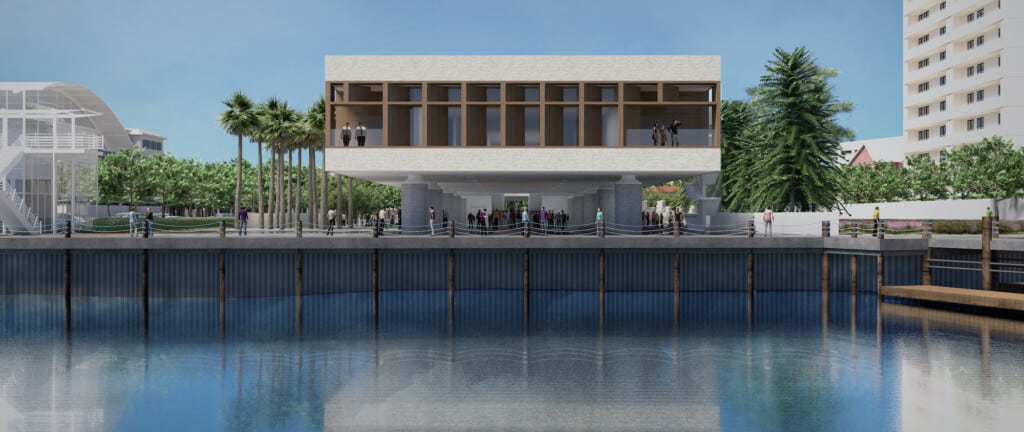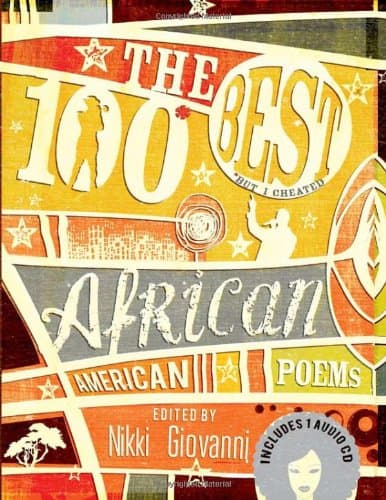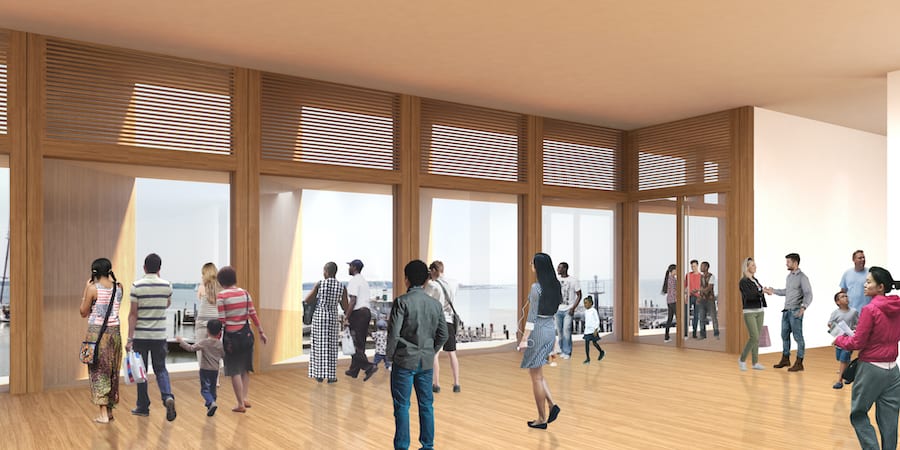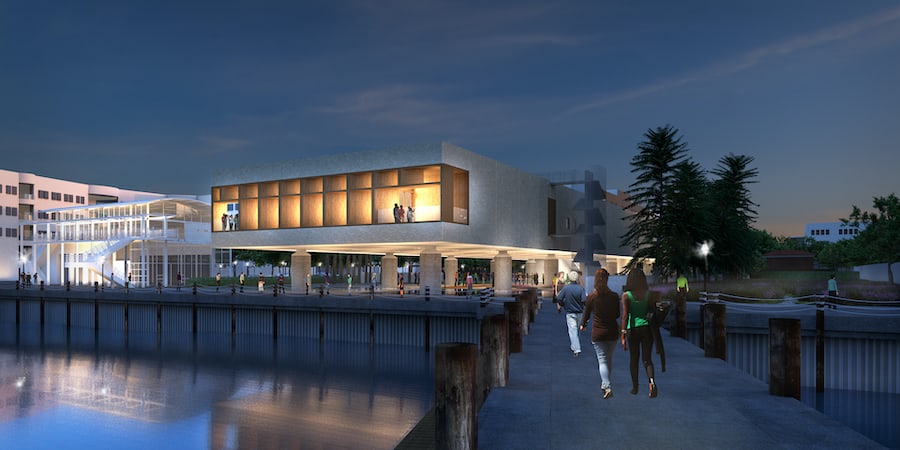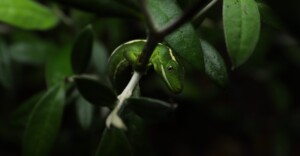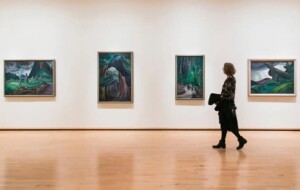Dr Tonya Matthews, an engineer, poet and thought-leader in institutionalised equity and inclusion frameworks, social entrepreneurship, and the intersectionality of formal and informal education, is CEO of the International African American Museum (IAAM).
Located in Charleston, South Carolina at the historically significant site of Gadsden’s Wharf, the museum is scheduled to open in 2022. The IAAM will feature the African Ancestors Memorial Garden, which will be free and open to the public, a place to reflect, experience botanic gardens, artistic installations, a huge infinity fountain on the edge of the original wharf, a soundscape that explores diverse African languages, performances, and programmes.
Solomon Group, an award-winning leader in exhibit fabrication, AV systems integration and live event production, is the fabricator and AV integrator for this project. Ralph Appelbaum Associates (RAA), a multidisciplinary firm specialising in the planning and design of museums, exhibits, educational environments and visitor attractions, is the exhibit designer. The IAAM is designed by New York-based architectural firm Pei Cobb Freed & Partners.
Dr Tonya Matthews
Before joining the IAAM, Dr Matthews’ previous roles have included Associate Provost for Inclusive Workforce Development & Director of the STEM Innovation Learning Centre for Wayne State University and President & CEO of the Michigan Science Centre. While at the Michigan Science Centre, she founded The STEMinista Project. This is a movement to engage girls in their future with STEM careers and tools.
She continues this work today through STEMinista Rising, supporting professional women in STEM – and the colleagues who champion them – with an inclusive emphasis on women of colour.
Noted as one of the Most Influential Women in Michigan (Crain’s Business, 2016) and honoured as Trailblazer by Career Mastered Magazine (2017), Dr Matthews is a member of the National Academy of Sciences Board on Science Education. She was also appointed by both Democratic and Republican administrations to the National Assessment Governing Board.
A published poet, her work is included in 100 Best African-American Poems (2010) edited by Nikki Giovanni, and she has written articles and book chapters on inclusive governance, non-profit management, and fundraising.
She received her PhD in biomedical engineering from Johns Hopkins University and her BSE in biomedical and electrical engineering from Duke University, alongside a certificate in African/African-American Studies.
A strong background in STEM
Dr Matthews spoke to blooloop about her background in STEM, the International African American Museum, and STEMinista and STEMinista Rising initiatives.
“I’m the oldest of four, which means I have the gift of gab,” she begins. “I grew up in the Washington DC area, in the school systems there, and I was a math and science kid. Actually, I was a school kid. I was good at math and science, and I also read everything I could get my hands on. I went off to college down here in the Carolinas at Duke University, and had some very interesting experiences there.”
Matthews received her undergraduate degree from Duke University in biomedical and electrical engineering, and her doctoral degree from Johns Hopkins University in biomedical engineering.
“Obviously, we talk about what it’s like for African-American students at predominantly white institutions. I have all the stories, all the moments that resonate, and I think what was interesting was my reaction to that was, ‘I’ll be fine, but what about everybody else?’
“I was coming into college very well prepared to succeed at that level. But I realised that that’s not what I was being judged on. I started to worry about everyone else. And I also started to discover books I’d never read, authors I’d never heard of. That’s when I discovered Toni Morrison, which is an awakening for anyone. I discovered the story of Angela Davis, which resonated with me.”
A passion for education
Angela Davis, an American scholar, political activist and author, emerged as a prominent counterculture activist in the 1960’s. She is best known for her leadership of the Communist Party USA as well as her close association with the Black Panther Party during the Civil Rights Movement.
“Most of the time when we talk about black history and struggle and resilience, which is, obviously, what the museum will talk about, we tend to focus on people coming from these challenging backgrounds.
“I was beginning to question whether someone who came from my environment, roughly middle-class, went to school and college, could be talking about this stuff too? That was Angela Davis’s background, too, and clearly, the answer was yes, given what she went through.”
We need other environments for people who maybe don’t enjoy the classroom. That’s what led me to museums.
By the time she reached graduate school, studying engineering, Matthews had begun to realise that she enjoyed and had a knack for sharing information.
“In retrospect, I’m an educator’s child, and that brushed off on me,” she says:
“But I think that my experiences at Duke, and somewhat also at Johns Hopkins and grad school, reshaped the way I thought about education in a way. I realised that a classroom works for these folks. But we need other environments for people who maybe don’t enjoy the classroom.
“That’s what led me to museums.”
Diversity and inclusion in the museum space
She started out volunteering at a museum:
“And then they gave me a job. I realised that it was the kind of learning environment that had many, many doors: the idea being that we meet you where you are and get you to where you want to go, and we have the freedom to do that right, versus a classroom, where you need to come in through this door, and you need to get to this point right here, so we can let you out the other door.
I realized that these kinds of spaces had to be partners to the classroom.”
That began her career in museums.
“I had a ball,” she says. “We still have a lot of work to do. But it is an environment where you can actually say something for all children, something for all people.
“As I climbed the leadership ladder, as I got into executive leadership and began to circulate, sitting on boards, being in committees and councils and representing outside of that environment, I began to think more deliberately around these conversations around diversity and inclusion. As an African-American female leader, there is my job, and then there’s my job, right?
“But I’m also a nerd. At some point, I decided, well, this is always going to be my second job. I might as well learn and practice and certify and get into that space.”
Dr Matthews and the IAAM
Accordingly, she began working a bit more deliberately in the diversity and inclusion space:
“I took some time back in academia, which was good.”
While she was at Wayne State University, she got the call asking if she would be interested in considering a role at the International African American Museum.
“A colleague had recommended that I throw my hat in the ring. I was stunned and humbled. This museum is so big and so important. I would have considered myself a charter member, I was going to join, be right there, support.”
“I did not think that I would be in the running to think about leading the IAAM. Because I’m not a trained historian. But in some ways, I think that makes me an exceptional choice. I’m a reader. I’m curious, I have lived experiences, I know how to run a museum, I know how to run nonprofits, but I’m not a history expert.
“And when I think about who’s going to be coming to the IAAM and why they’re going to be coming, that may be the experience they’re bringing: ‘Well, I’m not a history expert. I don’t know, is it okay if I don’t know this stuff when I come into the room? Am I supposed to know this? Should I feel bad that I didn’t know this?’
“I understand what that learning curve is like, what that self-doubt is like. And so as we think about how we built this museum to welcome folks in, through all of those different doors, I’m able to share in that experience.”
The International African American Museum
Turning to the concept behind the International African American Museum, she says:
“It’s interesting. The now-former mayor of Charleston, Joe Riley, read a book called Slaves in the Family by the journalist Edward Ball. Mr Ball has roots, and it was that journey of a white American family discovering that they had owned slaves.”
This is, of course, Charleston, South Carolina. There is no shortage of stories that we have to tell here
Slaves in the Family, a meticulously researched personal quest, confronts the legacy of slavery connecting Ball’s South Carolina family and the people they enslaved:
“Reading that book started to open up and shape some ideas for the mayor. He began to enlist support, feeling that this should be talked about more.”
This led to the concept of opening a museum.
“This is, of course, Charleston, South Carolina. There is no shortage of stories that we have to tell here. Out of those conversations came a better understanding of Gadsden’s Wharf and what that meant in terms of slavery and the American role in the slave trade.”
IAAM at Gadson’s Wharf
Gadson’s Wharf was the first destination for an estimated 100,000 enslaved Africans during the peak of the international slave trade. It is estimated that 40% of the enslaved Africans in the United States landed at Gadsden’s Wharf.
“The extraordinary percentage of enslaved peoples that came into slavery through the spot where we’re building the International African American Museum began to add impetus and sacredness and importance to the conversation,” she says.
“The IAAM has grown from there. We’ve had Henry Louis Gates, who’s very interested in helping everyone, African-Americans as well, trace their genealogy and understand their history; we’ve had the Secretary of the Smithsonian, Lonnie Bunch, talk about how rare and important it is for us to be able to talk about history and stories at the site of those histories and stories.
“Being from the Washington DC area, the Smithsonian was my backyard museum; when he talks about the power of place, I think that really clicks.
“It has been about a 20-year journey, between thinking through the ideas and the storytelling, and raising the funding that we needed to pull this together.”
The power of storytelling
Matthews contends authentic storytelling is a powerful tool in the fight against entrenched, institutionalised racism. She explains:
“One of the things that we’ve come to honour and understand is the power of story. Folks love stories. We know that we, as human beings, resonate with a really good story, and they last forever. So there is the power in story to change hearts and minds and to put our world in context.
There is the power in story to change hearts and minds and to put our world in context
“I also think that intuitively we can tell when stories have important elements that are missing. I think we can tell when stories are false, we can tell when stories have agendas. And that has been one of the challenges with telling the stories of African-Americans. The way that we have told those stories has been fraught with various agendas, various missing pieces.
“I think there’s a part of us that can feel that something is missing, that is not quite right. This robs a story of its power and its ability to challenge and disrupt this institutionalized and systematic racism.”
Authentic stories at the International African American Museum
But how can a story do those things?
“I think it’s because people resonate with people,” says Matthews. “There’s a concept in sociology and psychology that talks about how it’s easier to relate to the pain of one person than it is to the pain of tens of millions.
“Many of these concepts, institutionalised racism, systematic racism, critical race theory, have been dehumanised. This, frankly, allows us to be a little too objective. Not allowing our emotions and our immense humanity into the story robs it of considerable power in dealing with these entrenched things.”
“It robs us of our power of restoration. It robs us of our power of apology. And it robs us of our power of empathy.
“All of those things are necessary in going forward, and that is where the importance of the authentic and empathetic storytelling of these critical pieces of American history lies. The story of African-Americans well before the slave trade, because our story does not begin there.
“There is also the need to come to terms with the fact that our story doesn’t end there either. I think we need authentic storytelling to get that.”
Exhibits at IAAM
Dr Matthews outlines the International African American Museum’s themes and exhibitions:
“The IAAM is organised geographically rather than chronologically, but I’m going to lead you through in a chronological way.
“For example, we will have the African Roots and Routes. This introduces many of the countries and former empires of central and west Africa. It talks about these communities, but it also begins to talk about the slave trade, reminding us, as Americans, that this was a global enterprise.”
“It’s not just about recognising where we came from, but recognising where we were dispersed to; it’s about connections to the diaspora.
“You can step from there into the IAAM’s Carolina Gold and South Carolina Connections gallery. We’re not a South Carolina museum. We are a national and international museum. But just as every story can have a main character and a perspective, the power that we have is to pull out the South Carolina connections to this very big, national and international conversation.”
Carolina Gold
Carolina Gold is a reference to rice, which was one of the critical cash crops:
“It was an incredibly lucrative industry for South Carolina, and almost entirely built upon the backs of the enslaved peoples who came with the expertise. We can tell the story and we have the evidence that we were importing enslaved peoples who already knew how to rice.
“South Carolina couldn’t quite get it right until those peoples were brought here and enslaved in service of that. It is also incredibly difficult manual labour. There are snakes, mosquitoes, and alligators.”
“Rice became the industry, the economic powerhouse of this community. It is, therefore, responsible for the building blocks of these institutions. On the one hand, the IAAM talks in that space about the horrors and the work of the enslaved peoples. But we don’t do that without talking about their skills and what they were bringing to the table.
Expertise and community
“So this is also where we’re talking David Drake, the now-renowned enslaved potter whose work now goes for six figures when it comes up at auction.”
David Drake (1800–1874) was an influential African American ceramic artist. He was enslaved from birth under the pottery-making families of Edgefield, South Carolina.
“One of the incredible stories is around what we call the low country. Here in South Carolina, the low country is the Gullah Geechee community. Now the Gullah Geechee peoples went all the way from North Carolina down through Florida. But South Carolina’s Charleston is an epicentre of the Gullah community.”
“These are communities of enslaved peoples who came and survived because of the way the coast is organised; there are all these sea islands and swamps. A lot of the plantations and enslaved communities were quite isolated. The positive aspect of that isolation is that it allowed these communities to preserve their culture, their food, their language.
“This continues to this generation; it’s one of the things that is really special about our community. That gallery at the International African American Museum is a nod to our particular place in this space.”
American Journeys at IAAM
The International African American Museum will also feature the American Journeys gallery:
“Here, we are talking about reconstruction, post-reconstruction all the way through Jim Crow, through modern times. There are copy replicas of voting booths and praise houses, talking all the way through to modern times.
“In many ways, we are telling stories that people are familiar with. With the civil rights movement, for instance, we are trying to pick out different portions of the story that folks may not know or understand. And we are focusing on South Carolina’s community role in that.
“Last, but certainly not least, is what is going to be one of our jewels: IAAM’s Centre for Family History.”
Exploring family genealogy at the International African American Museum
The IAAM will also have an active family genealogy centre.
“I think that everyone will resonate with that. But African-Americans have a particular challenge in moving backwards through genealogy,” she explains:
“We intuitively associate that with slavery. A good example of how something like that is institutionalised is that until 1870 enslaved peoples were not recorded in the US census by name. It would be the master, three male adults, two adult females, five children. So an African-American can trace their roots back to around this 1870 period. But then they hit what we call the wall of 1870.”
“Part of what our genealogy centre will have is a level of expertise in ways of getting over the wall, under the wall, through the wall. We are in the midst of a call now for family Bibles. We are asking folks if we can make copies of those because of the way grandmothers and great-grandmothers kept records in the Bibles. Then there are military records from the Civil War. The military keeps very good records.
“Then there were the types of slave roles where the slave masters were loaning out their slaves, much like you would loan out equipment or livestock. There’s horror in that, but of course, people tend to keep track of what they have loaned out. So, some of those documents may have names.
“That is what will make our genealogy library unique, and that’s going to be where our particular genius lies.”
Technology at IAAM
The International African American Museum is also using technology to immerse visitors in its stories:
“The STEM person in me is very excited about that,” Matthews says. “We’re using technology to enhance the story, help folks engage, and also add some ‘wow’ factor. We have a 32-foot-wide, 7 ft tall crystal LED screen covering one entire wall. It’s going to be magnificent: very big, very immersive.
“Think about when we are talking about the journey across the Atlantic. Just imagine kind of the visualizations that we can do with something of that size.”
Interactive storytelling
There is also technology within the exhibitions themselves at IAAM, making them interactive, and allowing first-person storytelling.
“We’re also going to be asking questions,” she says:
“There is hi-tech, and then there’s low tech. Low tech is good. Folks like low tech: magnets, whiteboards, those kinds of things. And then we’re also going to have an interactive mapping table, powered by Google. Here, we will talk about various sites related to the conversations we’re having in the museum.”
“We’re going to start with South Carolina, and then expand to the world. What a win looks like is if you come to the IAAM, you spend hours in the museum, and you decide, this is not enough, where else can I go? That’s where we want folks to be able to engage with the table. Maybe send things to their phone and their email of other places they want to go.
“Or, ‘I just read this story. Wow. That’s her house. That that’s where that home is still, is still located. That’s the site of the Avery school for Coloured People.’”
In short:
“We have a lot of technology integrated at the International African American Museum to help with the story. This is in addition to the behind-the-scenes bells and whistles needed, for example, at the genealogy library.”
Reaching wide audiences
Finally, in terms of reaching the broadest audience possible, Matthews says:
“One of the things that I’m excited about for the IAAM is that we already have nearly 20,000 charter members of the museum. More than half of our visitors are not local, so folks are getting that this is a national conversation. But they’re also getting that this is a conversation about South Carolina and the low country.
“I think that has been a big wake-up call for us that a broader audience is at least curious. So, it is up to us to deliver on a space that welcomes an audience that broad. This is the story we have been designed to tell, and that we are being built to tell.”
Creating a welcome and an invitiation
“So how do we create spaces of welcome? How do we create spaces for safe public learning? Not everyone likes to learn in public. So we are thinking about how we can do that, and also about how to create conversation and reflection. What good is a fact, if you don’t use it? Or if you can’t figure out what it has to do with your world and your life?
At IAAM, we need to honour that very broad base of curiosity. We need to create a welcome and invitation for that audience
“At IAAM, we need to honour that very broad base of curiosity. We need to create a welcome and also an invitation for that audience. Plus, we need to be a facilitator of the infamous question: ‘So now what?’
I think that’s part of what I’m really excited about. What success looks like for me is people coming through the space and then saying, ‘OK: now what?’ That means that they’ve taken in enough new information, good, bad, ugly, and inspiring, and they feel armed. That is going to be one of the superpowers of the International African American Museum, if we can get it right.”
STEMinista
A biomedical engineer and former CEO and president of Michigan Science Centre, in 2016 Matthews helped launch the STEMinista Project to engage middle school girls about science.
She explains:
“I like to joke that the two toughest words in the English language are ‘racism’ and ‘algebra’; they are words that inspire fear and denial.
“Coming up as a young lady who was interested in and very good at STEM, and who went into the space of engineering, I realised that we need more deliberate space. I think it came out of the fact that at some point I realised that my personality and never-say-never attitude have a big part to do with how I was able to overcome the various barriers and naysayers and discrimination that I faced.”
“But what I want is a world where my personality is not necessary for success. If there are a bunch of alphas in the room, we will never get anything done. The STEMinista project was created as a movement, as an initiative, to counterbalance the narrative.”
“The STEMinista project was designed to have conversations with young ladies. To have them early and often, all the way down to fourth grade, getting them to think in that space and in that way.”
STEMinista Rising
“Then the STEMinista Rising project was what I also began to acknowledge. Even once we have the degree and we’re out there in the real world, we still need community, we still need reinforcement,” adds Matthews.
“The STEM fields have a significant retention problem with women. And that is obviously much more cultural than it is about the capacity of the women in the field. The STEMinista Rising project is a sort of a lifelong continuum.
“Women in STEM have choices. We’re incredibly smart. We’re incredibly well-trained, and we also know how to problem-solve. This means we don’t leave STEM fields and become homeless; we leave these STEM fields and become successful contributors in other sectors that know how to appreciate us.
“What I am also seeing is folks choosing not to be in certain environments. That doesn’t help the country. It doesn’t help the culture.
“So as well as the communities that are being held back and the genius that we are wasting, we also have situations where companies or communities are not as successful as they could be. That’s because folks have chosen to put their talents elsewhere, where they feel better appreciated. We’ve really got to stop that brain drain in that way.”
